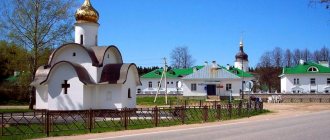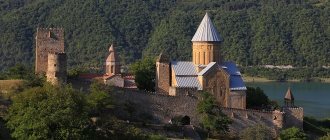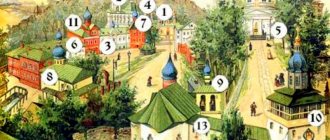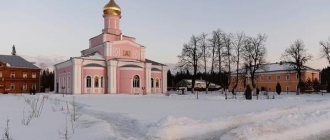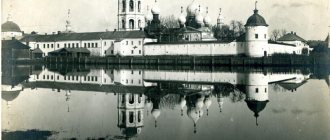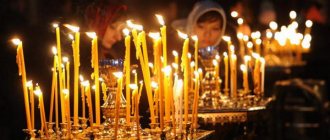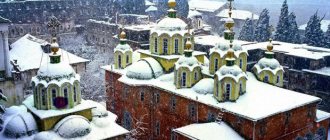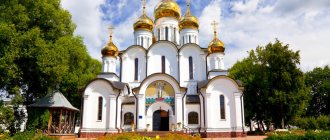***
The monastery in this place was founded in the mid-16th century. All the buildings were wooden, so the monastery burned down several times, and throughout the history of its existence, the monastery was completely destroyed three times: first by the Poles in the Time of Troubles, then during a major fire in 1675 and the third time during the Great Patriotic War, when in 1941 the enemy German aircraft bombed the monastery churches to the ground. Now the monastery is being revived again, since 2008, under the leadership and care of Abbot Boris (Tulupov). But even 15 years ago, looking at the overgrown wasteland and the ruins of the only surviving building, the idea of restoring the monastery seemed utopian.
Photo from the monastery archive.
All buildings on the territory of the Nikolo-Malitsky monastery, with the exception of the fraternal building made of white stone from the 18th century, are new. But this does not make the beauty and uniqueness of the temple in honor of the Intercession of the Most Holy Theotokos lose at all. It was built on a historical site where the destroyed Church of the Intercession previously stood (in the Western style of Peter the Great's Baroque), and even follows its architectural boundaries. But that's where the similarities end.
The new Intercession Church of the Malitsky Monastery was built in the Svyatogorsk neo-Byzantine style. This is a copy of the Church of the Holy Belt of the Virgin Mary of the Vatopedi monastery on Mount Athos.
The temple is very special and amazing. It is divided into three parts, each of which has its own services. As soon as you cross the threshold and walk through the doors inlaid with stained glass, you immediately find yourself... no, not in a fairy tale or in a magical world, but in the House of God, filled with harmonious beauty and piety. You shake off the worldly vanity at the threshold, forget yourself and feel a special grace, even if you are far from the Church. Although there is a firmament here with golden stars and the sun, and living lights, and miracles. It is not for nothing that all the Byzantine cross-domed churches, built in the likeness of Hagia Sophia in Constantinople, became prototypes of paradise or the kingdom of God on earth.
The monastery has a Greek church charter (strikingly different from the Russian one); it combines the charters of two monasteries on Mount Athos - the pre-revolutionary Russian Panteilemon Monastery and the Serbian Hilandar Monastery. Services are held in Greek and Church Slavonic; a Byzantine choir sings during services.
Content
- 1 Nilo-Stolobenskaya men's hermitage
- 2 Annunciation Convent (Bezhetsk)
- 3 Olgin convent in the Volgoverkhovye region
- 4 Vorontsovsky Annunciation Convent
- 5 Vyshnevolotsky Kazan Convent
- 6 Dmitrovsky Kashinsky Monastery
- 7 Nikolaevsky Klobukov Convent
- 8 Ascension Orshin Convent
- 9 Zhitenny Convent
- 10 Krasnokholmsky Nikolaevsky St. Anthony Monastery
- 11 Assumption Monastery (Staritsa)
- 12 Catherine Convent (Tver)
- 13 Nikolo-Malitsky Monastery
- 14 Assumption Zheltikov Monastery
- 15 Assumption Otroch Monastery
- 16 Nativity of Christ Convent (Tver)
- 17 Boris and Gleb Monastery
- 18 Tikhonovsky Toropetsk Convent
- 19 Nikolo-Terebensky Convent
- 20 Glebova Pustyn (Glebovo)
- 21 Nikolsky Skete of the Zhitenny Monastery (Krapivnya)
- 22 Holy Transfiguration Okovets Skete
Nilo-Stolobenskaya men's hermitage[edit]
The monastery is located on the Stolbensky island of Lake Seliger, on the site of the hermitage of St. Nil Stolobensky, 10 km from the city of Ostashkov.
In 1528, the hermit Nil Stolobensky settled on the island of Stolobnoye in Lake Seliger. Before that, for thirteen years he lived in a dense forest on the banks of the Seremkha River, but there he could not hide from human glory. In the first year of his life on the island, he digs a small cave in the mountain where he spends the winter. In 1529 he built a hut and a chapel on the island. On December 7, 1554, the Monk Neil died, and in 1560 a chapel was erected over his grave.
In 1591, Hieromonk Herman came to the island, who, over the course of several years and with the help of several people, erected a wooden church on the island in honor of the Epiphany of the Lord, with a limit in the name of St. Basil the Blessed.
In 1594, the “islanders” received a blessed letter from the Patriarch of Moscow and All Rus' Job to open the Nilova Pustyn Monastery; this year became the year the monastery was founded.
Address:
172757, Tver region, Ostashkovsky district, p/o Svetlitsa.
Telephone:
8(48235)5-08-04 (office), (monastery hotel).
Annunciation Convent (Bezhetsk)[edit]
Date of foundation
: 1994
Status
: valid
Address
: Tver region, Bezhetsk, st. Nechaeva, 43
Telephone
: (231) 2-42-80
Named in memory of the former Annunciation Monastery. Due to the impossibility of re-creation in the old place, the sisters were initially placed in a stone 2-story house from the 1890s (formerly a parochial school), near the Church of the Savior and Cemetery. There is no separate monastery church.
Olgin convent in Volgoverkhovye[edit]
Date of foundation
: 1649
Status
: valid
Address
: Tver region, Ostashkovsky district, village. Volgoverkhovye
Web
: https://svolgi.ru/
The first monastery at the source of the Volga was founded as a men's monastery (Volgoverkhovsky Preobrazhensky Monastery) in the middle of the 17th century. by decree of Tsar Alexei Mikhailovich. It existed until the beginning of the 18th century, gradually falling into decay. In 1724 after a big fire it was abolished. A new revival of the monastery began in 1907 as a women's community in the Volgoverkhovye region, which was assigned to the Vyshnevolotsky Kazan Convent. Soon (in the same year) the Olga community received the status of a monastery and became independent. In the 1920s the monastery closed. In the 1960s there was an attempt to create a historical and cultural reserve on its basis. In the 1990s, the monastery was returned to the diocese and restored as a convent.
Vorontsov Annunciation Convent[edit]
Date of foundation
: 1898
Status
: save
Address
: Tver region, Toropetsk district, Vorontsovo village
The convent was formed in 1903 from the community on the estate of Sofia Pfeiffer and Claudia Perepechina, with the participation of John of Kronstadt. In 1925 it was closed, all buildings were transferred to the agricultural artel.
Vyshnevolotsky Kazan Convent[edit]
Kazan Monastery
- Orthodox convent of the Kazan Icon of the Mother of God in Vyshny Volochyok in Krasny Gorodok on the eastern outskirts of the city.
The Kazan monastery was founded in 1881 from a women's community that had existed since 1872, founded at the expense of Prince Putyatin. Here was a Greek icon representing a half-length image of the Mother of God without the Child of God. This holy icon was first the home shrine of Emperor Andronikos III Palaiologos, then he donated it to the Monemvasian monastery in Morea (Greece); when the Turks attacked this monastery during their invasion of Greece in 1821, the holy icon was transferred by Abbot Agapius to the city of Patras; after the death of Agapius, according to his will, it went to his relative, the Russian Consul General N.I. Vlasopulo, whose son donated it to Emperor Nicholas I in 1839; in St. Petersburg, the holy icon was kept in the Winter Palace until 1868, and until 1877 in the Trinity Cathedral on the Petersburg side, from where on May 1, 1877 it was transferred to the Kazan Monastery.
Address
: Russia, Tver region, Vyshny Volochek, Red Town
Dmitrovsky Kashinsky Monastery[edit]
Dmitrovsky Monastery
(Dimitrievsky) is an Orthodox monastery in Kashin, which supposedly arose at the end of the 14th century.
Originated on the Kashinka River. There is no reliable information about the time and founders of the temple; Moreover, according to folk legends, it was founded in the 15th century by the Monk Macarius of Kalyazin, who accepted monasticism in the Nikolaev Klobukov Monastery. The longevity and significance of the monastery is evidenced by the fact that its abbots have been known since the first half of the 16th century: in particular, Archimandrite Barsanuphius (about 1521) and Misail (1544-1551).
The name of the monastery was given by the temple in honor of the Holy Great Martyr Demetrius of Thessalonica. In 1609, the Dmitrovsky Monastery was burned and plundered by the Poles, after which it was rebuilt. In the 17th-18th centuries, owning numerous villages, arable lands and forests, the monastery became the largest and wealthiest in the area.
The Dmitrovsky Monastery, surrounded by high walls, became a place of detention for some disgraced persons. So, in the local monastery cell, Prince Gustav, Duke, son of the Swedish king Eric XIV, who, according to the chronicle of Behr, was buried in the monastery, spent several years in captivity. Since 1764 it was a provincial monastery.
Address
: Tver region, Kashinsky district, Kashin city, Inna Konstantinova street, territory of Kashinsky technical school
Nikolaevsky Klobukov Convent[edit]
Date of foundation
: no later than the beginning XV century
Status
: valid
Address
: Tver region, Kashin, st. Smychka, 6
Telephone
: (48234) 2-35-00
Web
: https://klobukov.ru/
Founded as a monastery no later than the beginning. XV century Known as the place of monastic tonsure of St. Macarius Kalyazinsky. Closed in the 1920s. Reopened in 1994 as a women's one.
Ascension Orshin Convent[edit]
Date of foundation
: no later than 1st half. XVI century
Status
: valid
Address
: Tver region, Kalininsky district, village. Orsha
Orshin Ascension Monastery
- a female (formerly male) Orthodox monastery of the Tver diocese in the Tver region at the confluence of the Orsha River with the Volga, 18 km from Tver.
Living Convent[edit]
Zhitenny (Zhitny) Smolensk Monastery
- an Orthodox convent of the Tver diocese, located one and a half kilometers from the city of Ostashkov, on the island of Lake Seliger Zhitny.
Founded in 1716 as a men's town, on the site where the town of Klichen was previously located. The monastery is dedicated to the Smolensk Icon of the Blessed Virgin Mary.
From 1773 to 1930, a Necropolis was created on the territory of the monastery, where clergy, zealous investors and representatives of famous noble families were buried. Many memorial monuments were erected at the expense of the heirs and relatives buried in the cemetery.
In the 1920s it was closed by the Soviet authorities. The necropolis was destroyed. Many slabs were used for the construction of city houses and structures, and some went into the ground.
On June 17, 2002, by decree of the Archbishop of Tver and Kashinsky Victor and the Holy Synod, it opened as a women's monastery.
Address
: Tver region, Ostashkovsky district, Ostashkov, Zhitnoye peninsula, 3.
Krasnokholmsky Nikolaevsky St. Anthony Monastery[edit]
Date of foundation
: 1461
Address
: Tver region, Krasnokholmsky district, Sloboda village
The monastery was founded by Rev. Anthony Krasnokholmsky, who came to the Mologa River from the Belozersk side. The three-tiered stone bell tower (1668) housed the monastery library and archive. Since 1809, the Krasnokholmsky Theological School was located in the monastery. During Soviet times it was closed and almost completely destroyed.
The relics of the founder, Venerable, were kept hidden in the monastery. Antonia.
In 2010, Archbishop Victor of Tver and Kashinsky decided to prepare to register the monastery as a functioning monastery.
In August 2013, the Krasnokholmsky St. Nicholas Monastery was registered as the Krasnokholmsky St. Nicholas Bishop's Compound. Hieromonk Siluan (Konev) was appointed rector of the metochion.
Assumption Monastery (Staritsa)[edit]
Date of foundation
: beginning XII century
Status
: valid
Address
: Tver region, Staritsky district, Staritsa, st. Pushkina, 1
Telephone
: (48263) 2-36-35
Web
: https://www.fondumstar.ru/
Staritsky Holy Dormition Monastery is an Orthodox male monastery in the Tver diocese. Located in the city of Staritsa on the Volga River above the mouth of the Verkhnyaya Staritsa River.
Catherine Convent (Tver)[edit]
St. Catherine's Convent
The monastery was established in 1996 on the basis of the Church of the Great Martyr Catherine. This Baroque church was consecrated in 1781.
The icon of the Mother of God “Don’t cry for me, Mother,” which recently appeared in the monastery, attracted attention with unusual phenomena. When the restorer was working on the icon, a light suddenly emanated from the face of the Mother of God, brightly illuminating the entire room. When they tried to photograph the icon after this, the camera did not work until they decided to pray. The number of sisters in the new monastery is about 20. There is an almshouse at the monastery.
Working women are accepted.
Divine services. Morning services on weekdays at 7 a.m., on Saturdays at 8 a.m., on Sundays and major holidays at 9 a.m. Evening services at 5 p.m.
Tel.
Address:
st. Kropotkina, 19/2
Nikolo-Malitsky Monastery[edit]
The monastery was founded between 1584-1598. on the Shevyakov wasteland. The monastery was named after the Malitsa river. At first the monastery was very poor. After the Time of Troubles, through the prayers and labors of a small brethren, life on Malitsa gradually began to get better. People flocked here, and a settlement arose nearby.
In 1675, the entire monastery burned down due to a strong fire. Among the ashes and sand, an icon of St. Nicholas the Wonderworker was discovered, which miraculously survived such a strong fire. In 1676, with donations from a Tver nobleman, steward Grigory Dmitrievich Ovtsyn, instead of a burnt wooden church, a five-domed stone church in the name of the All-Merciful Savior with two warm chapels was built: St. Nicholas and the icon of the Most Holy Theotokos Hodegetria. The fraternal cells and services in the monastery were restored. In the second half of the 18th century. Major stone construction began in the monastery.
In 1751-1760, at the expense of Countess M. G. Shuvalova, the monastery was almost completely rebuilt; the construction work was supervised by architect. P. Ya. Pluskov.
In 1829, according to the design of I. F. Lvov, the fraternal building was rebuilt.
Address:
Tver region, Kalininsky district, village Nikolo-Malitsa, st. Shkolnaya, 17.
Assumption Zheltikov Monastery[edit]
Date of foundation
: 1394
Architect
: Fedorov A.P. (1912) - construction on his own. project (monastic building(s))
Address
: Tver region, Tver. st. Borikhinskaya (village of Borikhino)
The monastery was founded by St. Arseny Tversky on the bank of the river. Tmaki near Tver, in a place called Zheltikovo. After the death of St. Arseny was buried in the monastery, in the vestibule of the Spassky chapel of the Assumption Monastery. The monastery enjoyed the patronage of Ivan the Terrible and Peter I. It was closed in 1928, in 1930 the new and old bell towers were destroyed, and aviation workshops were located on the territory. In 1941, during the retreat of Soviet troops from Kalinin, all churches and the abbot's building were blown up. After 1945, a military fuel and lubricants warehouse was built on the territory. In 2011, it was decided to establish a courtyard of the Nikolo-Malitsky Monastery here, and restoration of the monastery is planned.
Assumption Otroch Monastery[edit]
Date of foundation
: 1265
Otroch Assumption Monastery is an Orthodox monastery in Tver. Founded in the middle of the 13th century. In the 1930s, all monastery buildings, with the exception of the Cathedral of the Assumption of the Blessed Virgin Mary, which has survived to the present day, were destroyed.
Tradition connects the founding of the monastery with Gregory, a youth of the Tver prince Yaroslav Yaroslavich. While hunting, he saw the beautiful Ksenia in the vicinity of Tver and wanted to marry her. The parents were not against it, but the prince liked Ksenia and became his wife. Gregory then took monastic vows. The chronicle for 1265 reports the founding of the monastery:
“by the care and diligence of the Grand Duke Yaroslav Yaroslavich of Tverskoy and the God-wise Grand Duchess Ksenia, after the consummation of their legal marriage in the fourth summer at the request and prayer of his beloved youth Gregory, and in the monastic rite Gury”
.
The Otroch Monastery became one of the largest Tver monasteries, the Tver chronicle was kept there (the Tver Chronicle Code of 1305), “The Tale of Mikhail Tverskoy” and presumably “The Tale of the Tver Otroch Monastery” were written.
In 1531, the Monk Maxim the Greek was exiled to the monastery, and spent 20 years within its walls. During his imprisonment, he wrote numerous theological works, including “The Word on God’s Unspeakable Providence,” “The Word is Soulful,” and “The Word on Repentance.”
Address
: Tver region, Tver, Afanasy Nikitin embankment, 1
Nativity of Christ Convent (Tver)[edit]
It is not known exactly who and when founded the Nativity of Christ Monastery in Tver. It was first mentioned in a charter dated 1514. There is a widespread legend that the monastery arose at the beginning of the 15th century with the blessing of the saint and wonderworker Arseny, Bishop of Tver.
During the Time of Troubles, the monastery was ruined and was in decline for a long time. But from the end of the 17th century it began to improve and achieved a better position. Nevertheless, until the beginning of the 19th century, all the buildings of the monastery remained wooden. The main shrine of the monastery was the miraculous Tikhvin Icon of the Mother of God, brought to the monastery in 1703.
Address
: Tver, st. Barrikadnaya, 1-1 A
Boris and Gleb Monastery[edit]
Boris and Gleb Monastery
— a large monastery in the city of Torzhok; considered the oldest in the Tver region.
The monastery “does not have a scrap of written history until the 16th century, and the lists of abbots are opened by Grozny’s henchmen.” From the hagiographic literature of the 17th century it follows that the monastery was founded in 1038 by the boyar Ephraim, who was the equerry of the Kyiv prince Vladimir I Svyatoslavich. The reason that prompted the boyar to found the monastery was the murder of Boris and Gleb by Svyatopolk, after which he decided to retire from secular life and found a monastery on the banks of the Tvertsa River.
Initially, the boyar Ephraim allegedly founded the monastery on a hill near the river, and in 1038 a temple was built, which was named Borisoglebsky in honor of Boris and Gleb and gave the name to the entire monastery. In historical sources, the first information about Torzhok appears in the middle of the 12th century.
Address
: Tver region, Torzhok, st. Staritskaya, 7
Telephone
: 9-91-88
Tikhonovsky Toropetsk Convent[edit]
Date of foundation
: 2005
Status
: valid
Address
: Tver region, Toropets district, Toropets, st. Eremenko, 7
Web
: https://toropetz.narod.ru/
The convent was founded in the year of the 140th anniversary of the birth of Patriarch Tikhon.
The monastery was built on the site of the Nikolaevsky Special Monastery, abolished in 1764.
Nikolo-Terebensky convent[edit]
The Nikolo-Terebensky convent is a monastery of the Russian Orthodox Church, located in the village of Truzhenik (former name Terebeni) in the Maksatikhinsky district of the Tver region. Founded in the name of St. Nicholas the Wonderworker in the second half of the 18th century as a men's church. Closed in the 1930s, it has been revived as a women's club since the mid-1990s.
Address:
171935 Tver region, Maksatikhinsky district, village Truzhenik st. Sadovaya 24.
Glebova Hermitage (Glebovo)[edit]
In the village of Glebovo there is a stone church built in 1824 at the expense of parishioners. The first mention of the church dates back to 1689, when, according to the “import” document, a wooden church was built in the village. The first church in Glebovo was wooden; in its place there is a stone monument. In 1734, a new wooden church was built in Glebovo. The new stone church, built in 1824, has three altars: the main one - in the name of the Epiphany of the Lord and a side chapel: the right one - in the name of the Prophet Elijah and the left one - in the name of St. Nicholas. The bell tower was built in 1852 and has a height of 18 fathoms with its spire. The aisles were expanded in 1888.
In 2021, the Glebova women's hermitage was transformed into the courtyard of the Assumption Staritsky Monastery
Tver and Kashin diocese by Decree No. 69 dated April 8, 2019.
Address:
171380, Tver region, Staritsky district, Glebovo village, building 8
Telephone:
How to get there:
travel by bus from Staritsa to Babynin, then walk three miles
Nikolsky Skete of the Zhitenny Monastery (Krapivnya)[edit]
In the Russian outback, on the banks of the Krapivenka River in the village of the same name in the Tver region of the Ostashkovsky district, where only five families live, and even then mainly in the summer, a small wooden church, built and painted on its own, grew up in the name of St. Nicholas, Archbishop of Myra in Lycia, wonderworker . This is the Nikolsky monastery of the Mother of God Zhitenny Convent
.
Since 2009, several sisters have been living in the monastery - in great asceticism and labor. On December 19, 2014, on the patronal feast of the monastery, the first Liturgy was served in the Church of St. Nicholas the Wonderworker. Liturgy in the Temple is performed once a week - on Thursdays - on the day dedicated to St. Nicholas the Wonderworker - the Heavenly patron of the monastery. Every day, the sisters take turns reading the psalter and akathists in the church.
Address:
172769, Tver region, Ostashkovsky district, Krapivnya village
Telephone:
Email:
***
We are greeted by Father Nikodim - a very modest, friendly, sophisticated and erudite interlocutor. He is an artist and also works in an icon-painting workshop at the monastery. Father Nicodemus talks about the temple with such love and affectionate enthusiasm, as if it were some kind of living creature.
First, to talk, we sat down on high wooden chairs with varnished railings, standing along the walls for the congregation - stasidia. The young priest, who himself has visited Mount Athos several times, educates on the topic of the Greek charter and tells the history of the Nikolo-Malitsky monastery itself. But then, speaking about the special decoration of the Church of the Intercession, he cannot stand it - he gets up, arms himself with a long pole, although without a lit wick, and shows how during the service the monks swing the lamps and, most importantly, the huge chandelier in the center of the wheel - the horos. Chandeliers hang low on thick chains almost to the level of human height. And now the entire domed sky and the visible space around me are swaying to the beat of their own special rhythm, everything floats, captivates and bewitches.
— According to Svyatogorsk tradition, we do not use electric light during services. The brothers light candles on the chandeliers. On weekdays we pray practically in the dark, only a couple of oil cans are lit, but on the twelfth feasts, patronal feasts, on Sundays the candles on the lamps are lit, after which at the most solemn moment of the service the lamps are set in motion. The greater the holiday, the greater the number of candles that are lit. There is such a legend. One of the monks on holy Mount Athos had a vision during prayer: the heavens opened and a bright light shone, angels descended into the temple. When the choir began to sing, angels began to fly around the temple and touched the lamps with their wings. There are many different spiritual meanings of this custom, but I like the interpretation of St. Nicholas Kabasil - the movement of the lights in the temple symbolizes the movement of the stars in the universe, which glorify their Creator, says Father Nicodemus.
The temple was designed by Tver architect Mikhail Budkin. Unfortunately, he died in an accident on August 31, 2021: as happens most often, the driver who fell asleep at the wheel drove into the oncoming lane, where a collision occurred - an innocent person died. At that time, Mikhail had five children and a wife who was pregnant with his sixth. The main brainchild of the deceased Mikhail was the Intercession Church in the Nikolo-Malitsky Monastery, where its architect also worked as an altar boy.
A specially invited icon painter from Romania alone painted the entire temple for 7 years - all the wall scenes, domes, altar, iconostasis, porches, confessional - hundreds of compositions, more than a thousand figures depicted in the post-Byzantine style of Theophanes of Crete, copies of frescoes from the Athonite monasteries of Stavronikita and Dionysiatus. And the temple painting is crowned with the image of the Savior Pantocrator (Almighty) on the arch of the central dome.
And on the horos there are medallion pendants in the form of a double-headed eagle - the current state symbol of Russia was also once borrowed from Byzantium. By the way, similar choirs once illuminated the vaults of Hagia Sophia during services, and from there the tradition of swinging lamps originated.
— The architecture itself, the vaults and all the decoration of the temple, even the acoustics, are concentrated and directed towards the center. Thus, the temple is likened to a microcosm. All this was done in order to unite believers into a single whole, into some single entity, so that everyone would pray together, glorifying God in a single impulse. Western church architecture (basilicas) emphasizes the distance and distance between clergy (priests) and believers. We have a different concept. According to the Svyagogorsk rite, the priest at the Liturgy brings the Holy Gifts to the center of the church, to the parishioners. And Byzantine architecture expresses this idea of community and unity.
Shrines
Behind the walls of the young monastery there are two important shrines:
- the miraculous icon of St. Nicholas the Wonderworker, which survived the fire;
- shrine with the relics of St. Arseny of Tver - St. Arseny is the patron saint of the city of Tver and a monastic patron.
Icon and ark with a particle of the relics of Arseny Tverskoy in the Intercession Church of the Nikolo-Malitsky Monastery
***
The main shrine of the Intercession Church is the miraculous icon of St. Nicholas. The story of its discovery is amazing, as is the role that the famous image played for the monastery.
In 1675, the monastery was completely destroyed by fire; while dismantling the fire, the monks discovered an icon among the ashes under the rubble. Nothing survived that fire - not a single building, but the image remained untouched. After the icon was found, miracles began to happen—healings from illnesses. The monks still remained at the site of the monastery, people reached out, the monastery began to gradually be revived, and the icon became the main shrine.
In 1742, from the icon of St. Nicholas, Countess Mavra Shuvalova, maid of honor to Empress Elizabeth Petrovna, was healed. The woman was pregnant, traveling from St. Petersburg to Moscow and became very ill; she had to stop at a monastery. Mavra was getting worse day by day, and when there was no longer any hope left, the monks brought an icon of St. Nicholas and served a prayer service for the water. After drinking holy water, the countess fell asleep, and in the morning the noble lady was healthy. Arriving in the capital, Mavra gave birth to a healthy baby, whose name was expectedly given Nikolai. In gratitude, the Shuvalov couple rebuilt the wooden monastery into a stone one - along with the three-altar Spassky Cathedral, 7 churches, a bell tower, a refectory, residential buildings, walls, and towers appeared. Here, on the territory of the monastery, the Shuvalov family necropolis subsequently appeared.
After the revolution of 1917, the brethren were dispersed, but it is surprising that the monastery itself was not touched, declaring it an architectural monument. During the Great Patriotic War, we know that the monastery was bombed by the Nazis, leaving only the dilapidated Church of the Intercession and the fraternal building. Then the land went to the Niva collective farm, services even began to be held in the temple, but during the Khrushchev thaw it was blown up. Not for ideological reasons, but because of self-interest.
There was another “historical miracle” - Tver was twice saved from the plague of cholera: after the city was walked around in a religious procession with the icon of St. Nicholas, the epidemics began to fade away. The processions became annual, with the last religious procession taking place in 1927. According to Father Nikodim, healings from the icon are still happening, even non-believers - Muslims and Catholics - are recovering. Thus, among the gifts to the holy image, as gratitude, you can see a bracelet with coins on which Arabic script is visible.
Holy Transfiguration Okovets Monastery[edit]
The Okovsky forest is a unique place, “The Tale of Bygone Years” describes the Okovsky forest as a kind of geographical center, from where three great rivers originate: “... The Dnieper flows from the Okovsky forest and flows to the south... The Dvina flows from the same forest and flows to the north ... The Volga flows from the same forest and flows to the east.” So here, in the wilderness of the Okovsky forest, in the Selizharovsky district of the Tver region, in the ancient village of Okovtsy, an ancient spring gushes from a depth of more than 900 meters. Tradition says that it was at this place in the summer of 1539 that one of the two Okovets miracles - the Life-Giving Cross - was revealed. After which, among the dense and impenetrable forests, a healing spring began to flow with unprecedented power, “watering every weak nature with life-giving streams and giving healing to many blind, lame, deaf and other sick people.” Soon, not far away, the miraculous icon of the Most Holy Theotokos Hodegetria was found. From that time on, the icon began to be called Okovetskaya (Rzhevskaya). By decree of Tsar Ivan the Terrible, a temple was erected at the site where the icons were found, next to the Source. Streams of the purest water from the Source fill the deep round reservoir, clad in hewn granite back in 1870, by order of Tsar Alexander II.
Address:
172232. Tver region, Selizharovsky district, Okovtsy village, Holy Key
Telephone:
How to get there:
bus Tver - Selizharovo, then to Okovets
***
Father Nikodim answered questions about himself sparingly and modestly. We managed to find out that he was from Estonia, studied at the Moscow Theological Academy in the Holy Trinity Sergius Lavra, and in Tver turned out to be “God’s thought.” There are no monasteries in Estonia, so those who want monastic life are forced to leave there.
“We have created a small Byzantine world here, an Athos corner after the Tver forests. Of course, we live according to the Greek charter, there are differences in the service, and in the rules of monastic life, and in the decoration of the temple... But all this is only the external, formal side, even the beauty and sophistication in the decoration of the church, and most importantly - this is prayer and the inner spiritual life.
***
The singing of the Byzantine choir “Aksion Estin”, whose regent is Seraphim Ershov, adds special majesty and solemnity to the services in the monastery. Seraphim lived his entire childhood on Mount Athos in the Greek monastery of Dochiar, where he first became acquainted with the Athonite rites and Byzantine singing, which he was taught by the inhabitants of the monastery. He then continued his education on mainland Greece.
The name of the choir translates as “It Is Worthy” - this is one of the most revered images of the Blessed Virgin Mary throughout the Orthodox world, which is located on Holy Mount Athos. The main choir consists of five people. The artistic director of the group, Vsevolod Babitsky, spoke about the features of Byzantine singing.
All singers are from Russia, but studied in monasteries in Greece, including Mount Athos. Vsevolod ended up there at the age of 12, when his parents, on the advice of the family’s confessor, decided to send the boy to a church school at the St. Andrew’s monastery in the administrative center of Athos, where he lived and studied until he came of age. The school is amazing not only for its history, location and disciplines taught, but also for its international classes - Christians from many countries go to Athos to study - Romania, Serbia, Bulgaria, Kenya, Russia, Australia... All training and communication takes place in Greek, also in the program, in addition to the usual general education subjects: Latin, ancient Greek, icon painting, Byzantine singing, etc. There were only 8 people in the class, but it is not at all necessary that all graduates choose the path of serving the church - each has their own destiny. For example, one of Vsevolod’s classmates became... a pilot.
As for our singer, he continued his education at the Theological University in Thessaloniki, graduating with a bachelor's and master's degree. In 2010 he returned to Moscow. Once on a holiday I went to the Tver monastery, I really liked the monastery, after which Abbot Boris invited Vsevolod to stay in the choir.
— Athos became my second homeland, I loved this place very much. The monks of the Simonopetra monastery were trustees and spiritual mentors and surrounded me with care. Every weekend I came there, the monastery is very beautiful, built on a rock. I liked living and studying there so much that when I returned to Russia on vacation, I was homesick and wanted to go back as soon as possible. Now every time we come to Tver (editor’s note every weekend) and sing at the Nikolaevsky Malitsky Monastery, I remember Athos and seem to be transported there. And this feeling unites and inspires us all.
Schedule of Divine Services and Patronal Feasts
Divine services in the monastery can be attended daily:
- Monday, Wednesday, Friday - 6:00 Matins, 8:00 Liturgy, 17:00 Evening prayer;
- Thursday - 6:00 Matins, 8:00 Liturgy, 14:00 Akathist to St. Nicholas the Wonderworker, 17:00 Evening prayer;
- Saturday - 6:30 - Matins, 9:00 Liturgy, 16:00 All-night vigil;
- Sunday - 9:00 Matins, 11:30 Akathist to the “Inexhaustible Chalice” icon, 17:00 Evening prayer.
Important!
You can get acquainted with a more detailed schedule and changes during fasting and holidays on the official website of the monastery. May 22 is the patronal feast day of St. Nicholas the Wonderworker.
***
In Russia, singing during services is partes, characterized by polyphony. This Western culture, which came to us from Europe during the reign of Peter I. Byzantine singing is eastern, ancient, distinguished by its own musical phrases and color, having its own special musical system in the form of “hooks” - these are neumas. Byzantine singing is monodic. But an amazing thing: singers’ voices of different timbre create the illusion of polyphony. In addition, when a choir sings a chant, a vocal accompaniment sounds in the background of the words, accompanying the flexible and patterned melodious phrases. It somewhat resembles some kind of wind instrument. And in general, the ancient music revived centuries later is like a song from some saga - majestic, bright, soaring upward.
The singers take the scores of the chants from the repertoire of Athonite monasteries, where ancient music manuscripts are kept. Some works were transcribed into Church Slavonic to make it clear what the choir was singing about. However, there are both Bulgarian and Serbian chants, because Byzantine music is also heard in the churches there.
Now the Byzantine choir of the Tver monastery not only attends services in its native monastery, but also visits other churches in Russia and abroad; The choir recently recorded its first album, “Byzantine Liturgy.”
— Byzantine singing enriches our spiritual culture. It’s great when there is a choice - a person can go to a temple where there is a partes choir, or to a temple where there is a Byzantine choir. But in general, spiritual chants are designed to help people pray, become closer to God, and transform their inner world, adds Vsevolod.
Tverskoy River Station
In 1938, on the site of the destroyed Otroch Monastery, the River Station was built according to the design of architects E.I. Gavrilova, P.P. Raisky and engineer I.M. Tigranov. It became the highest port on the Volga. Before the construction of the Moscow-Volga Canal (Moscow Canal), during low water the Volga became so shallow that large Volga ships could not reach Tver. In 1969-75, 400-meter berths were built near the River Station.
The initial design of the river station in Tver
At the time of its heyday, the Tverskaya River Station received excursion and pleasure boats, and was designed to simultaneously serve 550 people.
The river station building from the Tvertsa side
In the turbulent 1990s, the importance of the Tverskoy River Station began to decline. Fewer and fewer ships came here, and the building began to collapse. Several times they tried to adapt it as a museum: in different years the Museum of Military Traditions and the Museum of Horror were located here. In 2011, the Tvertsa Center for Contemporary Art , headed by the famous Russian collector, gallerist and publicist Marat Gelman and artist Andrei Bilzho. Alas, the condition of the building by that time was such that the exhibition had to be closed by winter.
St. Catherine's Monastery and Tverskoy River Station, June 2016
River Station, June 2021
Windows, June 2016
River station wing and pier, June 2021
Pier and mouth of Tvertsa, June 2021
Pier, Tvertsa and Tveretsky Bridge named after. P.F.Bogomolova
Steps, June 2016
Central volume of the river station, June 2021
I really wanted the building of the Tverskoy River Station to be finally restored. So that life would boil here again, Volga ships moored. But these hopes were not destined to come true...
River station and the Church of the Assumption of the Blessed Virgin Mary of the former Otroch Monastery, June 2016
On the evening of August 7, 2021, the useless River Station in Tver began to collapse. The area of the collapse was more than 400 square meters. m. There was a partial collapse of the roof, floor coverings and the southern wall of the building. His further fate is unknown. Now the former River Station is surrounded by a construction fence, but no work has been noticed inside. The situation is further aggravated by the fact that this territory in the past belonged to the Otroch Monastery.
Ruins of the Tverskoy River Station, August 2021
Ruins of the Tverskoy River Station, August 2021
Ruins of the Tverskoy River Station, August 2021
